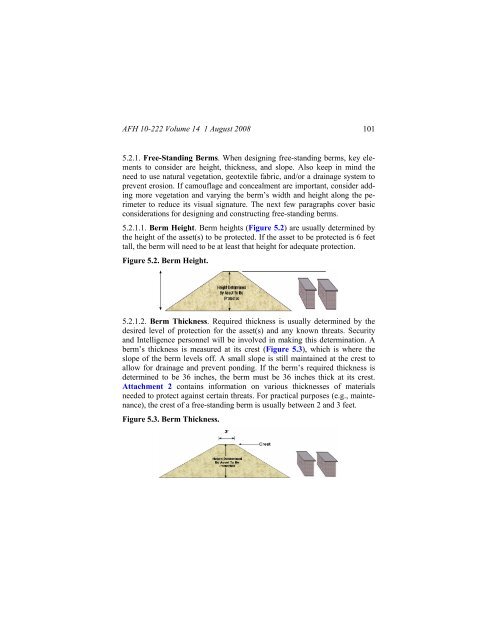Civil engineer guide to fighting positions, shelters, obstacles
Civil engineer guide to fighting positions, shelters, obstacles
Civil engineer guide to fighting positions, shelters, obstacles
Create successful ePaper yourself
Turn your PDF publications into a flip-book with our unique Google optimized e-Paper software.
AFH 10-222 Volume 14 1 August 2008 101<br />
5.2.1. Free-Standing Berms. When designing free-standing berms, key elements<br />
<strong>to</strong> consider are height, thickness, and slope. Also keep in mind the<br />
need <strong>to</strong> use natural vegetation, geotextile fabric, and/or a drainage system <strong>to</strong><br />
prevent erosion. If camouflage and concealment are important, consider adding<br />
more vegetation and varying the berm’s width and height along the perimeter<br />
<strong>to</strong> reduce its visual signature. The next few paragraphs cover basic<br />
considerations for designing and constructing free-standing berms.<br />
5.2.1.1. Berm Height. Berm heights (Figure 5.2) are usually determined by<br />
the height of the asset(s) <strong>to</strong> be protected. If the asset <strong>to</strong> be protected is 6 feet<br />
tall, the berm will need <strong>to</strong> be at least that height for adequate protection.<br />
Figure 5.2. Berm Height.<br />
5.2.1.2. Berm Thickness. Required thickness is usually determined by the<br />
desired level of protection for the asset(s) and any known threats. Security<br />
and Intelligence personnel will be involved in making this determination. A<br />
berm’s thickness is measured at its crest (Figure 5.3), which is where the<br />
slope of the berm levels off. A small slope is still maintained at the crest <strong>to</strong><br />
allow for drainage and prevent ponding. If the berm’s required thickness is<br />
determined <strong>to</strong> be 36 inches, the berm must be 36 inches thick at its crest.<br />
Attachment 2 contains information on various thicknesses of materials<br />
needed <strong>to</strong> protect against certain threats. For practical purposes (e.g., maintenance),<br />
the crest of a free-standing berm is usually between 2 and 3 feet.<br />
Figure 5.3. Berm Thickness.
















